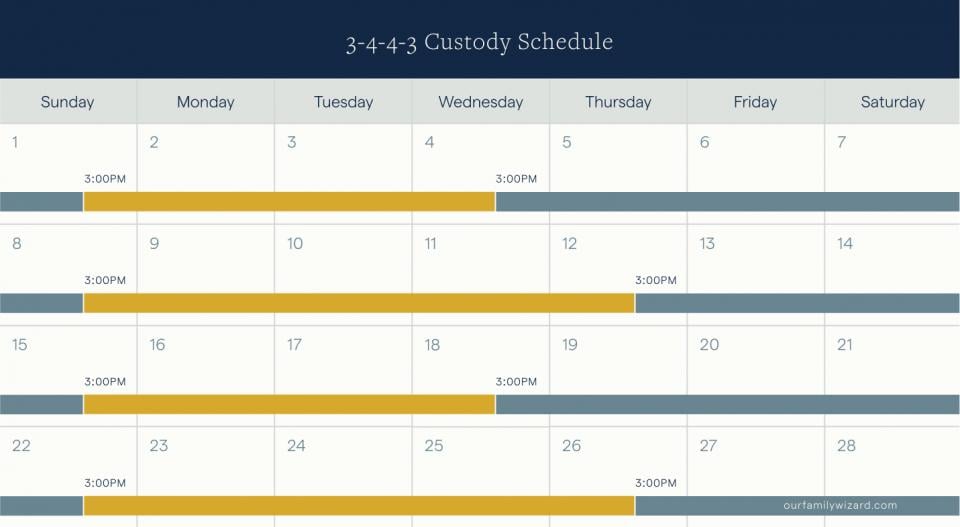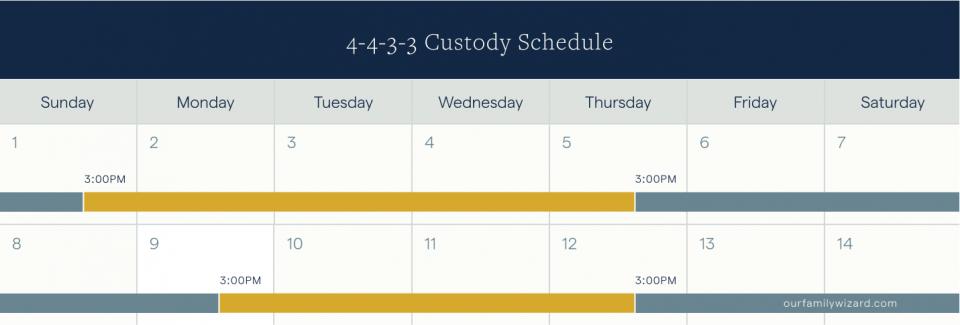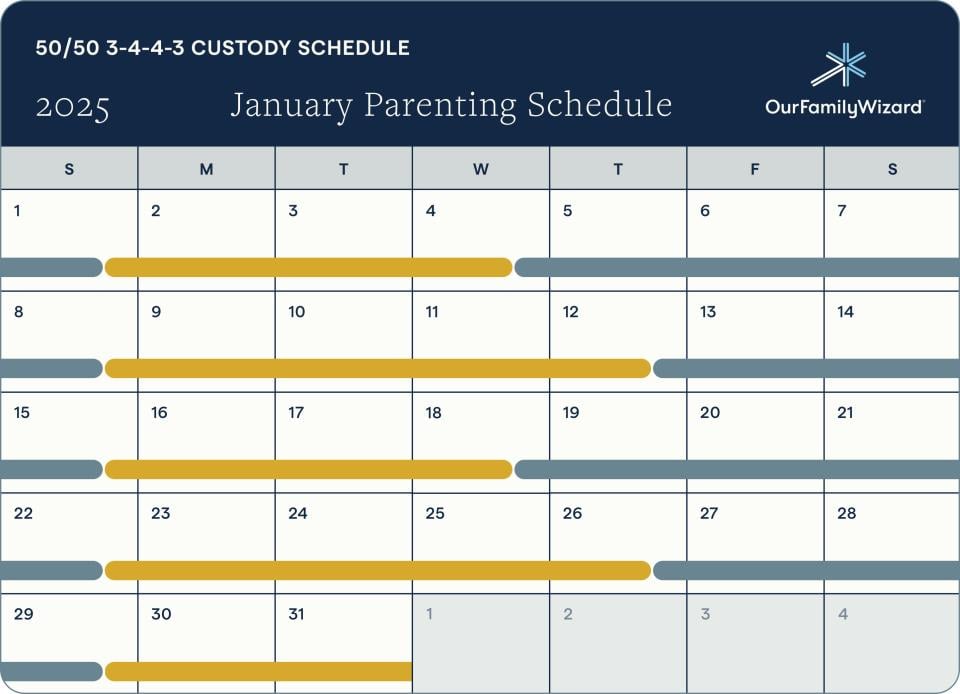3-4-4-3 Custody Schedules: Benefits, Challenges and Expert Tips
Managing a single family across two homes can be overwhelming. Find extra help in this comprehensive guide on the 3-4-4-3 parenting schedule. Learn from expert tips, download a free custody schedule template, and explore the benefits of shared co-parenting calendars on a 3-4-4-3 rotation.
What Is a 3-4-4-3 Custody Schedule?
A 3-4-4-3 parenting schedule is a shared parenting model where co-parents alternate between three- and four-day periods with their children. Some co-parents modify the schedule for weekends and special occasions like holidays.
You'll often see the 3-4-4-3 schedule rotation referred to as a "custody schedule" or a "parenting schedule."
Shared parenting arrangements that give both parents equal time with their kids have grown in popularity worldwide. This growth doesn’t surprise experts—splitting parenting time 50/50 can create a healthier family dynamic and help kids develop secure relationships with both parents. In fact, in a review of 40 studies published in the Journal of Divorce & Remarriage, Dr. Linda Nielsen writes that “children in shared parenting families had better outcomes on measures of emotional, behavioral, and psychological well-being, as well as better physical health and better relationships with their fathers and their mothers.”
Of course, 50/50 arrangements introduce new complications that parents with other schedules don’t need to consider. Instead of one house being the dominant residence, parents with shared physical custody must navigate the logistical challenges of frequent exchanges. For all 50/50 schedules, the parents should live near one another and communicate well.
But, apart from these universal requirements, different templates accommodate other needs or limitations. Selecting the right parenting plan goes a long way toward ensuring that your family makes a smooth transition toward co-parenting.
Co-parents who want a consistent schedule may favor the 3-4-4-3 schedule. The 3-4-4-3 schedule includes just one mid-week exchange, one of the fewest of all 50/50 schedules. The schedule may not be ideal when the co-parents have a strained relationship and aren’t willing to change the schedule around weekends and holidays.
Jennifer L. Lavin, Ph.D., J.D., describes the 3-4-4-3 as a balance between minimizing both time away from children and excessive rotations. “The 3-4-4-3 schedule provides for equal parenting time for both parents without what some parents may consider to be overly large gaps in time (e.g., a 5-2-2-5 schedule,)” notes Lavin. She also points out that the schedule “provides a rotation for parents who don’t want their parenting days limited to certain days of the week.”
Ph.D., J.D., describes the 3-4-4-3 as a balance between minimizing both time away from children and excessive rotations. “The 3-4-4-3 schedule provides for equal parenting time for both parents without what some parents may consider to be overly large gaps in time (e.g., a 5-2-2-5 schedule,)” notes Lavin. She also points out that the schedule “provides a rotation for parents who don’t want their parenting days limited to certain days of the week.”
Any co-parents considering 50/50 custody should read on to learn more about the 3-4-4-3 schedule.
Key Takeaways:
- The 3-4-4-3 is one example of a 50/50 schedule where parents have equal time with the kids over a two-week period.
- Co-parents who want to use the 3-4-4-3 schedule should live near one another and maintain a relaxed, healthy relationship.
- Under 3-4-4-3, kids and parents will go only four days maximum without seeing each other.
- Co-parents can choose to start the 3-4-4-3 schedule on Sunday, so both get a weekend day with the kids.
- A shared co-parenting calendar helps co-parents stick to the schedule, communicate well, and request any changes.
How Does a 3-4-4-3 Parenting Schedule Work?
In a 3-4-4-3 parenting schedule, the first parent has the kids for three overnight visits, and then the second has them for four. Next week, the days swap: The first parent has the kids for four days, and the second has them for three.
Sometimes, people confuse the 3-4-4-3 schedule with the 3-4 schedule, which is a 60/40 schedule where one parent has the kids for 60% of the week, and the other has them for 40% of the week. To easily distinguish between the two, follow the numbers in the schedule. Like all custody schedules, the numbers in the title refer to the number of days each parent has the children for.
For the 4-3 schedule, the first parent in the rotation is with the kids for four days, and the other parent is with them for three. Then, the schedule restarts. In this case, the schedule never switches, and each parent has the kids for the same days every week.
For 3-4-4-3, the first parent is with the kids for three days, and the other parent is with the kids for four (3-4-4-3). Moving forward, the first parent gets the kids for four days and the other parent for three (3-4-4-3). Over two weeks, the kids get equal time with both parents.
Compared with other 50/50 schedules, the 3-4-4-3 provides a high level of consistency. Parents need to coordinate only one exchange day. This format creates an easy-to-remember schedule with only one mid-week transition day. Parents can start the schedule on any day to better split weekends.
For example, beginning the schedule on Sunday morning gives each parent a weekend day with the kids. Of course, parents can choose to add their unique flair to the calendar. For example, some add alternating weekend arrangements so that each parent can enjoy a long weekend with the kids.

Who Is a 3-4-4-3 Child Custody Schedule Good For?
Organized parents who thrive under a consistent schedule and live near one another do well under a 3-4-4-3 schedule. Also, children who don’t want to be apart from either parent for long benefit from the 3-4-4-3 rotation.
“A 3-4-4-3 schedule works well for co-parents who have an amicable relationship, stable work schedules, and whose children are adaptable to a rotation schedule,” Lavin says. “This schedule may not work well for co-parents whose work schedules are variable, and whose children need more regularity in terms of scheduling.”
Here's a breakdown of the families that may excel with a 3-4-4-3 schedule. Note that some of these considerations may change as a child grows older.
- Co-parents live near one another: The 3-4-4-3 schedule requires one exchange per week. This switch may sound simple but can be challenging if you and your co-parent live more than 10 to 15 miles apart. In this case, commuting becomes a significant hassle and can negatively affect parents, children, and caregivers.
Also, the kids will need to bring schoolwork and other personal items from home to home. Even the stress of just remembering what to pack can burden a young child. It’s inevitable: more than once, someone will forget to pack an important item. If you and your co-parent live nearby, this problem may not escalate into a big deal. On the other hand, if a forgotten piece of schoolwork creates a headache for one parent, your child may feel stressed or guilty and fall behind in schoolwork.
For any 50/50 arrangement, kids whose parents live near the same bus stop or in the same school district will experience fewer disruptions to their schedules and adjust better.
- Parents with stable work schedules:
 “The traditional 3-4-4-3 schedule has each parent having the same days each week with the exception of one alternating day,” notes Danielle Kestnbaum J.D., M.S.W. “This can be beneficial to parents who have different work schedules that might enable them to cut down on childcare costs where, as an example, one parent has Mondays off while the other has Saturdays off.”
“The traditional 3-4-4-3 schedule has each parent having the same days each week with the exception of one alternating day,” notes Danielle Kestnbaum J.D., M.S.W. “This can be beneficial to parents who have different work schedules that might enable them to cut down on childcare costs where, as an example, one parent has Mondays off while the other has Saturdays off.”
Also, many parents choose to split the schedule during the school week. If both you and your co-parent have strict job schedules with little time off, a midweek, after-school exchange will be stressful without outside help. At the same time, if your job schedules are variable—like one is an on-call doctor, for example—you may have difficulty sticking to the routine.
You can mitigate scheduling problems if you and your co-parent live near one another and the kids attend school. In this case, the kids can take the bus in the morning from one parent’s house and then take the bus back to their other parent’s house, making the exchange seamless and hassle-free.
- Parents with relaxed, cooperative relationships: The consistency of the 3-4-4-3 schedule can benefit parents. For example, suppose your child has recitals every Monday and football games every Thursday. In that case, you can plan exchange days such that the responsible parent for each extracurricular activity is kept consistent.
However, this consistency also can create issues, as Kestnbaum points out: “The traditional 3-4-4-3 is not ideal in situations where the co-parents’ relationship is strained to the point that the co-parents are unable or unwilling to attend extra-curricular events together. Because in such instances, one parent might miss all football games if the football games are on the same day each week and it’s the day that the other parent has the children.”
- Young children (pre-K and younger) and children with secure attachment: Research suggests that “young children need stability and predictability in their relationships with their caregivers since their first attachment relationships are still developing.
Likewise, older children who already have formed secure attachments to their parents will not want to be away from either parent for too long. In this case, the 3-4-4-3 schedule facilitates a healthy attachment style and fosters secure relationships that have already formed.
Pros of 3-4-4-3 Joint Custody Schedules
Many co-parents like the 3-4-4-3 schedule because it doesn’t keep kids apart from either parent for too long, helping them form healthy relationships with both parents. Also, the single exchange day helps everyone maintain their routines.
Here's a summary of the pros of adopting this parenting schedule:
- Frequent contact between co-parents and kids: Under the 3-4-4-3 schedule, a parent and child will only ever go four days without seeing one another. We know that, in most cases, frequent contact benefits everyone in the family, particularly younger children who need to see both parents regularly to create stable, healthy relationships. For parents that want to play an active role in their children’s lives, shared schedules like 3-4-4-3 make it clear that both parents have equal time and opportunity.
- Structured schedules and minimal exchange days: In many cases, parenting schedules compromise on either frequent contact or structured routines. For example, in the common 2-2-3 schedule, parents and kids go only a maximum of three days without seeing one another. However, this schedule demands more frequent exchanges.
3-4-4-3 attempts to minimize the number of exchanges as well as time spent apart. Co-parents keep track of only a single exchange day a week. Plus, except for this exchange day, the days each parent cares for the children won’t change. As a parent, this gives you the time to organize your social life and other commitments while minimizing confusion about which parent is responsible for your kids’ activities.
Also, co-parents have the flexibility to choose when to exchange parenting time: on the weekend or midweek. Both options have challenges, but the flexibility allows co-parents with diverse schedules and obligations to adopt the schedule.
Plus, many of the benefits of a 3-4-4-3 schedule overlap with those of other types of shared schedules. These benefits include:
- Children have access to the extended family and resources of both parents
- Each parent can impart their unique parenting style and experiences
Cons of 3-4-4-3 Joint Custody Schedule
Co-parents who live far away from one another will find the logistics of the 3-4-4-3 schedule difficult to manage. Sometimes, only one parent has the kids for the weekend, which can create tension and stress. For children, switching homes during the school week can be difficult.
Here are the challenges with a 3-4-4-3 schedule:
- “Parents whose work schedules are variable may be challenged by the 3-4-4-3,” Lavin says, “because there is no guarantee that these parents would not have work obligations that conflict with their desired parenting times.”
- Can create a tense co-parenting environment if one parent has the kids for the entire weekend.
- School-aged children may find midweek exchanges difficult.
- Parents must live near one another.
Examples of 3-4-4-3 Parenting Schedule
You can customize the 3-4-4-3 schedule to serve your unique scheduling needs and maintain a 50/50 split. To better understand your options, check out different variations of the 3-4-4-3 schedule, like 3-3-4-4 and 4-3-3-4.
You can start on any number in the 3-4-4-3 series and still maintain the same 50/50 split. These schedules maintain an equivalent number of days per parent as 3-4-4-3, but they start on different days of the rotation.
3-3-4-4 Schedule:
Here, one parent is with the kids for three days, then the other parent is with the kids for four days. Afterward, the schedule repeats, but now both parents get to spend four days each with the kids.
In most cases, parents start the plan on Sunday, making Saturday the only day that varies per week. This rotation ensures that both parents get a weekend day with the kids.
4-3-3-4 Schedule:
As the title suggests, the 4-3-3-4 is the inverse of 3-4-4-3. Instead of the first parent in the rotation starting with three days, he/she starts with four. Then, the other parent gets the children for three days. At the start of the second week, the first parent gets the children for three days, and the other parent gets them for four days.
Like the 3-4-4-3 schedule, 4-3-3-4 will give only one parent the entire weekend, unless both co-parents agree on alternating weekend visits or choose to start the schedule on a day besides Monday. For example, if both co-parents agree to start the schedule on Sunday, each co-parent will have a weekend day with the kids.
4-4-3-3 Schedule:
The 4-4-3-3 splits time with the kids into two repeating four-day and three-day intervals. If you start the schedule on Sunday, each parent will have a weekend day every other week.
For example, the first parent has four days, from Sunday afternoon through Thursday afternoon. Then, the other parent has four days, from Thursday afternoon through Monday afternoon. Now, the first parent has Monday to Thursday, and the other parent has Thursday through Sunday afternoon.
Free 3-4-4-3 Custody Schedule Template
Use our free 3-4-4-3 custody schedule template to picture what the parenting schedule may look like for your family. Experiment with different exchange days and variations to determine which rotation will fit your family best.
Questions to Ask When Considering a 3-4-4-3 Parenting Schedule
Ask questions together as a family to decide between a 3-4-4-3 schedule or alternatives. For example, you and your co-parent should discuss whether you can handle having to see each other at least once a week. Also, discuss the potential effects of weekly parenting time exchanges on the children.
Here are some questions that family experts advise co-parents to discuss before jumping into the 3-4-4-3 schedule:
- “Will there be logistical challenges because of a midweek transition?,” asks Kestnbaum.“These challenges can be related to the parents’ geographic distance from one another or the children’s schools. Or maybe the children will have difficulty remembering needed school supplies or projects in progress.”
- “Do the co-parents have a relationship where they can both comfortably attend extracurricular activities?” Kestnbaum says that’s another important question co-parents should discuss. “There may be instances where an important activity routinely falls on the same day each week, on a day that is always reserved for a specific parent. Such activities and schedules might be unknown at the time the co-parents create their schedule. So, it’s important for parents to ask themselves how it will work for both to be involved and how this arrangement might make them feel.”
Lavin advises parents to consider the following:
- “Is a 3-4-4-3 schedule practical given our work schedules?”
- “Does a 3-4-4-3 schedule fulfill the unique needs of our children? Will the schedule continue to remain practical as our children grow?”
- “Will all or portions of our holiday parenting times need to be planned on a separate schedule?”
Other questions should include:
- Do the co-parents live near one another (ideally within 10-15 miles)?
- Are kids comfortable in both homes?
- Are other caregivers or family members nearby to help if an unanticipated event creates an issue in the schedule?
- Are the kids young and still forming their attachments to each parent? Will they need equal time with both parents to form secure attachments and healthy relationships?
Simplify your 50/50 custody schedule
Keep your co-parenting organized with OurFamilyWizard.
Alternatives to 3-4-4-3 Parenting Schedule
Explore common alternatives to the 3-4-4-3 parenting schedule that still provide 50/50 custody. For example, parents looking for more structure may prefer the alternating weeks or two-week custody schedules.
Here’s a list of other 50/50 parenting schedules that co-parents commonly use:
- Alternating weeks parenting schedule: In the alternating weeks parenting schedule, each parent spends a whole week with their children at a time. Consequently, parents and children go seven days at a time without seeing one another. In many cases, parents add in a visit here or there to the alternating week schedule, like alternating weeks with one mid-week overnight stay at the other parent’s house.
- 2-week schedule: Co-parents who live far apart may prefer the two-week custody schedule. Under this rotation, kids stay with each parent for two weeks. However, two weeks may be too much time apart for younger children.
- 2-5-5-2 schedule: For families using the 2-2-5-5 custody schedule, the first parent has the kids for two days, then exchanges with the other parent for another two days. After that, the first parent has an entire five days with the kids, and the other parent gets the next five days.
Easiest Way to Manage a 3-4-4-3 Visitation Schedule
Successfully balancing custody and visitation schedules may seem like a juggling act. OurFamilyWizard’s shared calendar and communication tools help make shared parenting time schedules much easier to handle.
“A shared electronic calendar is helpful in enabling co-parents to stay organized and minimize conflict,” Kestnbaum says. It should be “easy to read and visualize the parenting schedule as well as holidays and events like doctor appointments, birthday parties, and recurring extra-curriculars.”
She adds: “This type of calendar is especially helpful if it includes access to customer support as questions often arise around calendar entries, changes to the entries, and even getting the parenting time and events put in correctly.”
OurFamilyWizard’s shared calendar tool has all the features you need to keep your family in sync with the 3-4-4-3 schedule. Requesting extra weekend time or navigating the holidays will be stress-free with tools like schedule change requests and a holiday scheduler. The single shared parenting schedule builder minimizes conflict, improves communication, and alleviates stress by keeping co-parents on the same page every week.
3-4-4-3 Custody Schedule FAQs
Explore frequently asked questions about 80/20 custody schedules. Find out what percentage is considered full custody, and how an 80/20 split affects child support, and whether it can provide stability, consistency, and a supportive environment for the child.
How can I implement a 3-4-4-3 custody schedule with minimal conflict?
A 3-4-4-3 pattern is a 50/50 custody arrangement, so it’s generally considered fair. You can share that it’s a predictable pattern that provides stability and consistency for children. It’s developmentally healthy for kids to have strong relationships with both parents.
If there is still conflict over the situation, consider working with a family therapist, parenting coordinator, or mediator.
Can a 3-4-4-3 schedule be court-ordered, or does it require parental agreement?
A 3-4-4-3 schedule can be court ordered, even if one or both parents disagree. On the other hand, if both parents agree, they can either follow a private parenting plan, or ask the court to make their parenting plan official.
Can the 3-4-4-3 schedule be customized for holidays, school schedules, and extracurriculars?
Yes, you can customize the 3-4-4-3 schedule. You can adjust holidays, school breaks, and extracurriculars separately from the main schedule. That way, you can make sure each parent gets to have meaningful time with their children during those occasions.
For example, if it’s your year for Christmas, but Christmas falls during your co-parent’s regular parenting time, you’d still get the children for that day.
Is a 3-4-4-3 pattern a popular custody schedule?
A 50/50 custody split is very common. A 3-4-4-3 pattern is less common than 2-2-3, 2-5-5-2, and every other week. Still, 3-4-4-3 might be a good solution for your family. It splits each week in half nearly equally.
Is 3-4-4-3 considered joint custody?
Yes, 3-4-4-3 is a 50/50 custody arrangement, which is nearly always considered joint custody. Both parents have equal physical custody. (Technically, a parent with sole custody could give their co-parent 50% parenting time, but that is unusual.)
Is a 3-4-4-3 pattern good for kids?
A 3-4-4-3 schedule is generally good for children's mental health and development because it lets them maintain regular, meaningful contact with both parents. This fosters strong relationships with both parents, which can help children feel loved, supported, and stable.
A Note on Terminology
In general, the term “physical custody” refers to which parent a child lives with. Today, many experts use other terms to describe this arrangement, like “parenting schedule” or “parenting time arrangement.” These new terms better represent a relationship and the parent’s responsibilities for their children. But just a heads up: this article uses these older and newer terms interchangeably.







